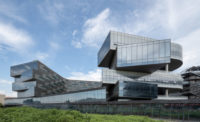London has been in search of its High Line since the day that the first phase of New York’s game-changing stretch of public space opened in 2009. Thomas Heatherwick’s Garden Bridge project was spurred by the desire of local leaders to have what New Yorkers had: an elevated piece of infrastructure, both garden and public space, with dramatic views of the city. That idea, which was much derided and unfairly lambasted, died in 2017. But now, another elevated public walkway has come to fruition: the Tide, designed by Diller Scofdio + Renfro in collaboration with Neiheiser Argyros, on the eastern reaches of the Thames, opened July 5—predictably drawing comparisons to the High Line from local media.
The developer-funded Tide is only partly elevated: the section that snakes up from the river, between residential towers on one side and office buildings on the other (by SOM, completed two years ago, and by Terry Farrell in the 2000s, respectively). This first phase stops just short of the Millennium Dome, the expo site from 2000, now converted into a performance venue.
North Greenwich, a peninsula containing the once-contaminated brownfield where the Tide is located, is a harsh and poorly designed place. The Tide is intended to be a catalyst for positive change to the public realm there, evolving from a 2013 master plan by the London practice AHMM, for the developer Knight Dragon. The current scheme includes commercial space, but also a strong residential component and an emphasis on loops of public pathways. DS+R, part of the High Line team, was invited to give ideas—which they now have turned into something exceptional.
Although the first phase of the Tide contains a 650-foot section of elevated walkway, it ultimately shares little with the High Line as it works to define a new part of the city. Indeed, if you are going to compare it with any other DS+R work, it has more in common with a new public space at the heart of Moscow, Zaryadye Park—particularly in the way the elevated walkway resolves in an architectural promontory, providing stunning views of the river and of the Emirates cable car line that traverses it. But trying to work out which of the firm’s previous greatest hits the Tide is riffing on is a pointless task. More interesting is the way it invokes the history of elevated walkways in London, particularly those surrounding DS+R’s other current project in the city, the London Centre for Music.
London’s famous Brutalist masterpiece, the Barbican, into which the London Centre for Music is being threaded, is set on an elevated plinth with cars and pedestrians separated vertically rather than horizontally. The partner in charge of the Tide for DS+R, Ben Gilmartin, has clearly studied these closely. This vertical separation “was one of the driving motives for the Tide,” says Gilmartin. “In the proposed future phases, it will cross over numerous roadways.”
Built from steel rather than concrete, the Tide’s first phase includes 28 “islands” supported by elegant, slightly splayed structural columns, each different. These are connected by prefabricated steel bridges that host gardens, trees, and walkways above while creating canopies beneath. Integrated into the sinuous form of the path are structures such as a café, wrapped in metal mesh, by Neiheiser Argyros. The overall effect is idiosyncratically British, reminiscent of that much maligned municipal architecture of the 1960s—albeit with a softer effect, thanks to the parametric forms of the steel structure and the textured greenery by the Scottish-Dutch landscape architects Gross Max.
When the full project is completed in the coming decade, the Tide will extend three miles in loops around North Greenwich, with a riverwalk at grade along the Thames. Working in the volatile world of private development in London is not for the faint of heart, but DS+R has defined and shaped a valuable piece of public space, which will exemplify an unprepossessing area of London for years to come—as important a task for the city as any High Line.








Post a comment to this article
Report Abusive Comment